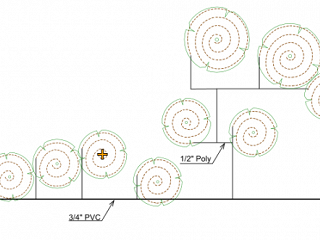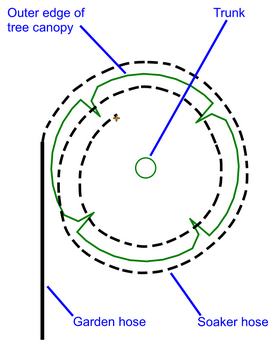A Tree-Hugger's Tips: Use Drip Spirals for Watering; plus How to Schedule Irrigation for Trees

People often ask me how to apply drip to trees, and how long to water. The method I’ll show you today is the way I drip trees that don’t have landscape plants beneath their canopies. When trees have plants beneath them, I handle them as part of the landscape area that includes all the plants. When trees are by themselves, I separate them out to have their own irrigation valve. Following is my method for watering them.
Trees are not watered in the same way as the landscape, in general. The way I address trees in my irrigation designs is by finding out how many gallons per week they need in peak time (July). Then I determine the length of inline tubing that it takes to deliver that amount of water in one hour. For example, if the tree requires 6 gallons of water per week in peak time, and I’m using .6 gph emitters on the site already for other parts of the landscape, I will need a length of emitterline tubing that will allow for 10 emitters.
Here’s the math: 6 gallons ÷ 0.6 gph emitters = 10 emitters
For newly planted trees, if you subscribe to the theory that you need to water new plants as if they were high water use until established, as I do, you would have two separate schedules for these trees - an establishment schedule and a mature schedule. The establishment schedule could last 3 to 5 years, since that’s how long it can take trees to get properly established.
You might ask how we know how many gallons per week a tree needs during peak time, or any time for that matter. Well, I created an app that provides that information. It’s freely available, and I invite you to use it. I call it the “How Much Water” app. It can be found at the following link.
https://puddle-stompers.com/waterwonk/how-much
An example:
Olive - (Olea europaea) 24” box
- Pre-establishment water use value: high
- Diameter at planting: 3 feet
- Water requirement in July: 5 gallons/week
- Irrigation tubing used in project is Netafim TLCV6-18
- Emitter flow of one emitter: 0.6 gph (gallons per hour)
- Number of emitters needed to provide 5 gallons per week, if the zone is run for one hour: 9 emitters (divide 5 gallons by .6 gph, then round up).
Here’s the math: 5 gallons ÷ 0.6 gph = 8.33 emitters (I round up to get 9 emitters)
So now I know that I need a length of emitterline with 9 emitters in it for my spiral. If the emitters are spaced every 18” (1.5 feet) on the tubing, it will take 14 feet of this emitterline.
Here’s the math: 9 emitters x 1.5 feet = 13.5 feet (round up to get 14 feet)
While the tree is getting established (3 to 5 years), you will run the zone 1 hour per week. Make the spiral nice and tight while the roots are still tight inside the root ball. You might even consider using Netafim EZ instead because it will make a much tighter spiral for establishing the new trees.
As the tree grows, you’ll need to add onto the spiral to accommodate the higher water requirement of the larger tree. I recommend measuring the diameter of the canopy once a year, and going through the process again to see how many emitters will be needed to provide the tree the required water at its current size.
As the tree gets bigger, you’ll also want to start moving the beginning of the spiral further out from the trunk, as the feeder roots are further out. It’s advised to start the spiral at 75% of the way out to the tree’s outer drip line and then extend this out several feet, once the tree is established. The roots of mature trees can extend out quite a ways from the dripline.
This graphic shows a spiral for a mature tree. It indicates being fed by a garden hose, but this could certainly be a drip zone instead.

I hope this helps you with designing and installing drip irrigation for trees that don’t have other plantings beneath them. Let me know in the comments if you would like more posts on this subject.
Note on soaker hoses: I normally don’t endorse soaker hoses because they clog too easily over time. I created this graphic as a quick guide for homeowners in drought conditions.


